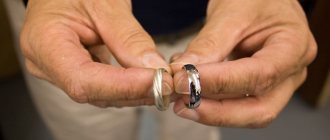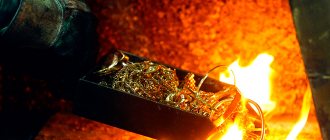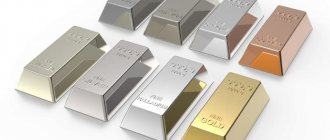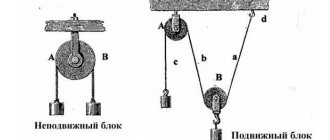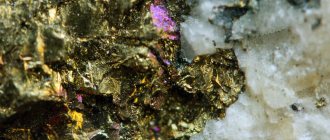What is it and what is it used for
The substance used for this manipulation is rhodium. This is a noble precious metal of the platinum group, inert and hard. Another advantage is its high reflectivity, thanks to which it shines brightly.
This substance was discovered relatively recently - in 1803. Its content in nature is extremely low. No more than 30 tons of rhodium are mined annually around the world. The metal has a high cost, but at the same time the demand for it is growing every year, as new ways of using it appear.
Why are rings plated with rhodium?
Rhodium coats items made of silver or gold. Rhodium plating will protect your jewelry from:
- rapid deformation. Gold and silver, which are most often rhodium-plated, are quite soft in themselves. Rhodium plating adds extra rigidity, strength and helps them retain their shape. This is especially true for rings that are often deformed;
- corrosion and oxidation. Rhodium is resistant to other substances and oxidizes only at high temperatures. Rhodium plated silver will not rust, yellow or darken over time like regular silver;
- dark coating. Of course, any piece of jewelry needs to be looked after, but rhodium-plated metals become dirty much more slowly than regular gold or silver.
RHODINATED JEWELRY
The cost of the 45th element of the periodic table (rhodium) significantly exceeds the price of other valuable metals. However, its use for processing jewelry accessories is quite justified. Platinum group metal has a noble silver-white color, is extremely durable and hard, it will reliably cover the surface of the jewelry and protect it from damage.
Due to the extremely high cost of raw materials, rings, chains and bracelets are not made from pure rhodium. They cover expensive items made of silver and gold. This gives rings, earrings, and chains a more presentable look - they shine brightly and attract the attention of buyers.
In the practice of jewelry craftsmen, this processing method is also used to protect precious metals from oxidation and corrosion. It is not afraid of scratches and damage; it does not dissolve in acids and alkalis. Plating jewelry with rhodium significantly extends its service life.
It is quite common to have a rhodium plated diamond set in a precious metal setting . Natural white alloys highlight the cold, natural brilliance of diamonds, making jewelry with them even more attractive and luxurious. A rhodium-plated diamond ring is a luxurious piece of jewelry that is very prestigious to own. Even a stone of not the purest water will sparkle with every facet. Such accessories are in demand as gifts for engagement or on a wedding day, because they will retain their original qualities for many years and can become a real family heirloom.
Advantages and disadvantages
Rhodium plating has its advantages and disadvantages, which have been identified by jewelry connoisseurs and professional jewelers.
This procedure has a number of positive characteristics.
- Treatment with platinum group metal gives the products a unique appearance. Rhodium-plated jewelry becomes more radiant, expressive and noble. In addition, this appearance is maintained even with intensive use of the jewelry.
- If you want to preserve an antique item made of precious metal, it is recommended to take it to a jewelry workshop and order a rhodium plating service. This treatment will change the chemical properties of the metal, and due to this, the service life of the products will be significantly extended.
- A layer of noble and light metal makes products less vulnerable to the negative effects of the environment, for example, to temperatures and various reagents. Treated products are not afraid of alkali, acids, chlorine and other aggressive components. This factor is important for those who wear jewelry almost always.
- Using rhodium, experts change the standard color of gold. In most cases, when using platinum group metal, a white glossy tint to the surface of gold jewelry is achieved. However, with the help of additional chemical elements you can give the product another unusual shade.
- Through processing, you can refresh old jewelry, giving it a modern appearance. This is a low-cost service that is affordable for everyone.
The main advantages regarding the use of rhodium in jewelry are listed. In fact, the advantages of such processing are much greater. Despite numerous advantages, this procedure also has its disadvantages.
The disadvantages are the following:
- Changing the appearance of a product is considered both an advantage and a disadvantage. The fact is that because of rhodium, it is difficult to visually determine the metal from which the jewelry is made. Some buyers who pay special attention to jewelry can determine the gold purity by eye. But not all users can do this. To avoid becoming a victim of scammers by spending money on a fake, you need to make a purchase in a trusted store. It is also recommended to check the documentation that comes with each piece of jewelry.
- The next disadvantage is the abrasion of the coating. Despite the strength and wear resistance of rhodium, during processing a thin layer is applied to the products, which wears off over time. In this case, you will have to constantly update the coverage, which means additional financial costs.
The visual effect of the treatment and its service life depend on the craftsman performing the work and other factors.
The rhodium layer can have different thicknesses, which range from 0.1 to 0.25 millimeters.
The wear resistance, practicality and resistance of the additional layer to external influences depend on this parameter.
Rhodium plating of gold and silver. Process Features
Rhodium is a metal of the platinum group, its brightest representative. “Bright” is used in the literal sense. The element shines like no other. The glow is cold, because the metal number 45 in the periodic table is white.
Rhodium is precious, does not oxidize, does not react with acids, alkalis, fluorine, sulfur, or chlorine. In jewelry, the element is used as an alloy for some alloys. But the main mission of rhodium is to coat jewelry.
What is rhodium plating
What is rhodium plating for jewelry ? This is covering them with a thin layer of metal. The spray thickness should not exceed 25 micrometers. The minimum value is 0.1 micrometer.
Any metal can be coated with rhodium, but this is not always practical, because the 45th element is more expensive than gold. Even in minimal doses, spraying only on precious items is economically justified. Rhodium plating is used on , white gold, platinum and other valuable white alloys.
Why cover white with white? There are two reasons. First of all, nothing compares to the shine of rhodium. Neither silver, nor gold, nor platinum shines like that. To make the decoration sparkle and attract buyers, it is “hidden” under element No. 45. Rhodium not only has more shine than other precious metals, but also durability. The coating protects products from scratches and other damage. This is the second reason to use rhodium plating .
The rhodium plating process and its features
What does rhodium plating mean from a physico-chemical point of view? The answer is the standard galvanizing process. In the school curriculum, the method is studied in the 6th grade. In Soviet times, the topic was always accompanied by visual experience. A copper coin was lowered into the galvanic bath. In a matter of seconds, the coin was covered with a white coating. It was not rhodium, but base metals. But the point is the same.
Liquid is poured into the container. It will act as a conductor for metal salts deposited on the product. In the work process, it is called cooking. It is negatively charged, and the particles of the deposited element are positively charged. When an electric current is passed through a liquid, the minus is attracted to the plus. As a result, the workpiece (anode) disappears under the coating layer (cathode).
The procedure requires water-soluble salts of the precious metal, but they are difficult to obtain. We need complex instruments and installations. Entrepreneurs took this into account and began to produce a ready-made composition - a concentrated solution of rhodium sulfate. To obtain a ready-made electrolyte, you only need to dilute the purchase in the required proportions with water.
Electroplated rhodium has a hardness of 900 kgf (kilogram-force) per square millimeter. The light reflectance is approximately 79%. The indicator is inferior to the reflectivity of silver. However, argentum fades over time. Rhodium shines equally strongly for decades.
It is no coincidence that the limits for the thickness of the rhodium coating are set. With an impressive layer width, element No. 45 is prone to internal stress. Its formation leads to the appearance of pores and microcracks in the material. In this case, the reason for rhodium plating of products loses its relevance.
Application of rhodium plating
In jewelry, the method is justified in several cases. The first of these is gold rhodium plating . What it is from a physicochemical point of view is clear. But what is this from an aesthetic point of view? The yellow metal is whitened with a ligature of silver, palladium, and nickel.
However, the final color of the alloy is far from perfect. It either remains slightly yellowish or becomes grayish. Another problem is the dullness of true white gold. Coverage required . Rhodium plating makes the products perfectly white. The latest trend is the lack of pre-bleaching of gold. The 45th element is simply sprayed onto it. The microlayer reliably hides the yellowness of the base.
White gold rhodium plating is the most widely used. They rarely work with silver. Spraying greatly increases the price of jewelry, which many people choose precisely because of its affordable price. However, elite silver models are rhodium plated. This relieves the base metal from darkening associated with the appearance of an oxide film on the surface of the product. Silver stops aging, does not require cleaning, and shines like a star in the sky.
In jewelry, jewelers like to combine diamonds with rhodium plating . That few people know this. Meanwhile, everything is simple—element No. 45 is used to cover models with diamonds. The stone often has cold shades - white, blue, pink. The radiance of such crystals is hidden against the background of yellow metal.
Meanwhile, white alloys highlight the natural play of light in diamonds. If, at the same time, the metal itself also has strong reflective properties, the irradiation of the diamond increases exponentially. Even a stone of poor purity seems perfectly transparent and sparkling.
The rhodium plated diamond ring is increasingly becoming the choice for an engagement or wedding ceremony. Lovers rely not only on the shine of their jewelry, but also on the fact that rhodium-plated jewelry will last longer. This is especially important for engagement rings that are worn for life.
It is worth noting that rhodium plating has found application outside of jewelry. For example, precious metal is implanted onto electrical contacts that operate at low voltages and low currents. This is due to the low electrical resistance of element No. 45.
Rhodium plating price
Prices for are set in most jewelry workshops. Only about 20% of them do not provide the service. In the rest, they charge about 800 rubles for covering the ring. This is the price tag for a medium sized product. It costs the same to spray a precious element onto a pendant. Rhodium plating of earrings will cost from 800 rubles to 2000 rubles. For chains, the price is usually negotiable. It all depends on the size of the decoration, weight, and type of weaving.
Technology
Nowadays, specialists working in the jewelry industry use several rhodium plating technologies. During this process, electrolysis is used.
This is a special physical and chemical process that requires special skills and abilities.
Before rhodium plating, it is necessary to prepare the jewelry. They are thoroughly cleaned using special solutions and polished. Then they degrease with alkali and wash - successively in hot and cold water. At the final stage of preparation, the products are kept for several seconds in a sulfuric acid solution. This is done in order to increase the adhesion of rhodium to the gold surface.
At the same time, a liquid solution of rhodium salts is prepared. The products are immersed in a bath of liquid through which an electric current is passed. During the processing process, the molecules of this platinum metal form an even and smooth layer.
The maximum coating thickness is 25 micrometers. This figure is 4 times less than the thickness of a human hair.
White gold plating
When using rhodium to process white metal products, an additional layer is applied over the entire surface of the product. This is due to the fact that the base alloy matches the color of the protective coating. Even if the top layer is erased or damaged, the difference will not be noticeable. In some cases, when working with light precious metals, rhodium plating is used for protective purposes.
Processing of yellow and red gold
In this case, the craftsmen adhere to the same technology as when working with white gold. The main difference lies in the partial application of rhodium to the surface of the product. The fact is that over time, the base metal will gradually begin to appear through the additional layer. As a result, the appearance of the decoration will deteriorate and the aesthetics will be disrupted.
When working with non-ferrous precious metals, only the stock for the stones is coated with rhodium, increasing their reflective ability. After treatment, the brightness of the shine increases significantly.
Rhodium plating is very similar to the gold plating process. In both cases, a thin layer of metal is applied to the product, which changes the appearance of the product and acts as protection. The main difference is that the rhodium layer gives a white color, and the gold plating gives a yellow color.
Types of processing
Rhodium plating is used for several purposes. There are several types of coating that have been used by professionals for decades.
Standard processing is used in most cases. With its help, products acquire a cool shine and a silvery tint. The coating lasts for a long time, extending its service life.
This coating option is used when working with gold, silver and even jewelry.
White metal frame enhances shine
Even in ancient times, it was noticed that faceted crystals look most advantageous in a frame made of white metal, which emphasizes the beauty and brilliance of the diamond.
For many years, highly transparent stones were set into items made from silver, which was the whitest known precious metal. Over time, silver tarnishes and black spots appear on it. If you do not clean it regularly, the black product takes on an unpresentable appearance, losing its shine.
For colored (usually yellow-brown) minerals, a red gold setting was perfect, as it enhanced the natural brilliance of the diamonds.
With the invention of the technology for producing palladium, the production of white gold began, which looks much more presentable than yellow and red and perfectly highlights the beauty of precious stones.
The shine of a diamond on a ring, pendant or earrings made of platinum is even more noticeable. This noble silver-gray metal is considered the standard of beauty. Its high price only emphasizes the elitism of the precious stone set in the frame.
Rhodium plating
Rhodium has a beautiful silvery-white hue for which it is highly prized in the jewelry industry. Its reflectivity is very high, the metal sparkles and shimmers, its shine is magnificent. Therefore, rhodium plating is becoming an increasingly popular procedure in jewelry workshops.
Rhodium plating is the application of a thin layer of rhodium (0.1 - 0.25 microns) to the surface of jewelry. The coating improves not only the appearance of metals, giving the surface a platinum shine, but also their chemical and mechanical properties. In addition, rhodium does not tarnish over time.
Advantages of rhodium plating: – brilliant platinum color; – resistance of the product to mechanical damage, scratches, etc.
Disadvantages of rhodium plating: – you cannot clean jewelry using abrasives, as the coating can be damaged; – after each repair of the product, it will have to be re-plated with rhodium.
Rhodium plating does not last forever, but its service life depends on several factors, the main one of which is thickness. According to user experience, renewal of the rhodium layer on rings, earrings, and chains is required once every five years and less often, depending on the intensity of use of the product. In many cases, high-quality rhodium plating will decorate the metal for decades.
Adding an elite metallic shine
Buyers are often interested in what the name “Rhodium-plated Diamond” is, and whether the stone is actually coated with a layer of platinum group metal. This concept is not true and there is no need to repeat it pointlessly.
A diamond is not a metal and cannot be plated with rhodium.
But applying a thin layer of rhodium to the metal part of the jewelry allows you to give it an elite appearance, and therefore increase consumer interest.
Due to its high hardness and strength, rhodium reliably protects the product from external damage, and uniform galvanic application allows you to hide the smallest scratches and roughness.
Against the background of a rhodium-plated frame, the diamonds sparkle well in the sun. The rays are reflected from the edges and will sparkle with all the colors of the rainbow. Most often, items made of white gold and platinum are rhodium-plated. Due to the high cost of rhodium, coating silver with it is considered unprofitable.
The main disadvantage of this method of improving the color of diamond jewelry is that the rhodium layer wears off over time and stains of the base metal become visible.
This is the main reason why rhodium plating is not recommended for rings and rings made of yellow and red gold. Such jewelry must be regularly taken to a workshop to restore the rhodium layer, which is impractical and expensive.
Types of rhodium plating
Rhodium plating is used to achieve several purposes: the formation of a hard wear-resistant layer, the elimination of blackness in silver jewelry that occurs during the oxidation of silver, giving the product shine, and decorating inserts made of precious stones.
Standard
With standard rhodium plating, jewelry acquires a silver color with a cool, bright shine. Due to its hardness, rhodium perfectly protects soft precious metals from minor damage and scratches, preventing wear. The product remains attractive for a long time and looks new.
Black
Black rhodium plating, while maintaining its protective benefits, can give the decoration the noble blackness of an expensive antique item. The coating can range from pale gray to jet black. Such items inlaid with black pearls or black stones look amazing.
The effect is achieved by changing the chemical composition used in the rhodium plating of gold, as a result of which a layer of black rhodium oxide is formed on the surface of the product.
Rhodium plating: jewelry processing technology
The rhodium plating process itself is quite simple, and it is based on the basic laws of physics and the competent work of a jeweler. The metal should lie on the surface of the product in an even thin layer, and this is achieved by performing several simple operations:
- The decoration is washed, polished and degreased;
- The product is lowered into a galvanic bath with a working solution, after which an electric current is passed through the liquid;
- Electricity passing through the solution catalyzes the release of rhodium, which is deposited on the surface of the jewelry in a thin layer.
The thickness of the protective layer depends on the duration of the procedure and the strength of the current passing through the solution.
You can purchase similar jewelry in the Jewel-classic online store. Here you will find an extensive collection of rhodium-plated jewelry. These are incredibly beautiful, durable and affordable jewelry that will pleasantly surprise even a lady with the most refined taste.
What is the value of rhodium?
This precious metal has gained particular popularity in such areas of production as jewelry, chemicals and glass. All this is due to its high melting point, namely 1965 degrees, and resistance to external irritants.
Rhodium is not the most expensive metal, but it is one of the most valuable, since its reserves in the world are very small - about several tens of tons. This is another of the fundamental factors that made it more expensive than gold. It is worth noting that the price had no effect on the high demand for rhodium.
Interesting! If we compare rhodium with other metals of the platinum system, it will be the brightest and have a high hardness rating. It can become softer only as a result of heating.
Pros and advantages of rhodium plating
In addition to the aesthetics of jewelry and improving its appearance, rhodium plating actually creates very strong protection both from external influences and for the person wearing the product. Even if the owner of a beautiful ring, chain, bracelet, or earrings is prone to allergic reactions, rhodium plating will eliminate this annoying phenomenon. The metal is completely hypoallergenic, does not cause skin irritation, leaves no marks on it, and also does not react with acids or chlorine.
It should be noted that rhodium plating is applicable to products of any complexity. Designer jewelry, with stones, in any condition, including brooches and other valuables, older than half a century or more. The application of a protective and decorative coating can be ordered immediately after purchasing a new one and with equal success - for decoration that has suffered from time.
Physical properties of rhodium
In appearance, compact rhodium is a beautiful silvery metal with a bluish tint. It has a face-centered cubic lattice, unit cell parameter a = 0.3803 nm. Density at 20°C 12.41 g/cm3. Melting point 1963 °C, boiling point 3727 °C. Unlike gold and platinum, rhodium is difficult to machine. Therefore, it can be rolled or drawn into wire only at 800…900°C. Exhibits paramagnetic properties. The reflectivity of the rhodium surface is 80% for the visible part of the spectrum.
Other characteristics:
- heat of fusion – 21.8 kJ/mol;
- heat of evaporation – 494 kJ/mol;
- specific heat capacity – 0.244 J/(K•mol);
- thermal conductivity – 150 W/(m•K).
Rhodium occurs in nature as a stable isotope – 103Rh. Its longest-lived isotopes with half-lives are: 101Rh (3.3 years), 102Rh (207 days), 102mRh (2.9 years), 99Rh (16.1 days).
Compact rhodium is extremely resistant to any chemical attack. However, if you take an alloy of rhodium with zinc or cadmium and dissolve it in hydrochloric acid and then filter it, you will get a precipitate of finely divided rhodium that can explode in air.
Why do you need rhodium plating?
Platinum and white gold are often coated with a layer of rhodium. This gives the products brightness and protects them from damage. It is worth noting that a separate metal called “white gold” does not exist in nature. White gold is an alloy of gold with a white metal - palladium, silver or nickel. The alloy turns out to have a yellowish tint, which somehow does not fit with the name. And the higher the sample of the material, the brighter the yellowness. Therefore, to give jewelry a beautiful color and shine, they are rhodium plated - rhodium plating is performed on jewelry.
This procedure has a positive effect not only on the appearance of the product, but also on its durability. Rhodium coating performs a protective function, since this metal does not tarnish over time and does not lose its color. Rhodium is less prone to scratches than gold, and a product with such a coating may not deteriorate for a long time even with daily wear. But this procedure is popular not only for white gold - rhodium-plated silver retains its shine much longer and does not turn black so quickly.
Advertising - Continued below
Chemical properties of rhodium
Rhodium is a noble metal; its chemical resistance in most corrosive environments is superior to platinum. Compact rhodium is not affected by either acids or alkalis. Only finely crushed rhodium slowly dissolves in hot aqua regia or concentrated sulfuric acid. Rhodium is also very resistant to the action of halogens: it reacts with chlorine, bromine and even fluorine only after prolonged heating. In this case, depending on the temperature of the reactions, halides of different compositions are obtained. In particular, mono-, di- and trivalent rhodium chlorides RhCl, RhCl2, RhCl3 are formed with chlorine. At high temperatures, rhodium slowly reacts with sulfur, turning into sulfides RhS, RhS2, Rh2S5.
Finely ground rhodium slowly oxidizes only at temperatures above 600°C:
4Rh + 3O2 = 2Rh2O3.
Rhodium exhibits a peculiar behavior when heated in air.
At temperatures from 600 to 800 degrees, an oxide film – Rh2O3 – forms on its surface. As the temperature rises from
800 to 1000 degrees the oxide film on the surface of rhodium again decomposes to metal.
When heated, rhodium slowly reacts with concentrated sulfuric acid:
2Rh + 6KHSO4 = 2K3Rh(SO4)3 + 3H2.
Rhodium hydroxide and oxide exhibit basic properties and react with acids to form Rh complexes:
Rh2O3 + 12HCl = 2H3RhCl6 + 3H2O;
Rh(OH)3 + 6HCl = H3RhCl6 + 3H2O.
In the presence of alkali metal chlorides, when it is possible to form [RhX3]3– complexes, rhodium reacts with chlorine, for example:
2Rh + 6NaCl + Cl2 = 2Na3[RhCl6].
During sintering, it reacts with Na2O2 and BaO2 melts:
2Rh + 3BaO2 = Rh2O3 + 3BaO.
Rhodium exhibits the highest oxidation state +6 in the hexafluoride RhF6, which is formed by direct combustion of rhodium in fluorine. The connection is unstable. In the absence of water vapor, hexafluoride oxidizes free chlorine or NO:
2RhF6 + 3Cl2 = 2RhF3 + 6ClF.
Rhodium is easily alloyed with platinum, palladium, copper and other metals.
Rhodium compounds are quite rare in everyday life and their effects on the human body have not been fully studied. Despite this, they are highly toxic and carcinogenic substances. Rhodium salts can strongly stain human skin.
Rhodium deposits and mining
Less than 30 tons of rhodium are mined annually in the world. The main exporter of this metal is South Africa (approximately 80%). Industrial mining of rhodium is difficult because the metal occurs in ores mixed with other metals such as palladium, silver, platinum and gold.
Previously, the main deposits were located in Russia. Impressive reserves of native platinum were found in the Urals. But now they have already been developed. Today Mexico is the leader in rhodium reserves. It is followed by South Africa and Colombia. There is precious metal content in the US gold sands.
Rhodium plating of gold jewelry. Regular care of rhodium plated jewelry
Caring for rhodium-plated gold involves following simple rules
- Store products in a special box or case.
- Clean and polish products using soft cloths and brushes.
- Protect them from contact with a damp environment and from contact with chemical reagents.
- Wear jewelry during the day, removing it at night and before applying cosmetics.
- When the rhodium layer wears off, you can take it to a workshop to renew it.
Obtaining rhodium
The technology for separating rhodium depends primarily on the type and composition of the processed raw materials. Let's consider the production of rhodium from native platinum.
From the mines, raw platinum goes to the refinery, where it is loaded into porcelain cauldrons and treated with aqua regia. The process occurs when heated during the day. As a result, rhodium goes into solution.
The solution is then treated with ammonium chloride to precipitate and separate the platinum. The remaining solution is evaporated: a precipitate is formed, which consists of several salts. It contains up to 6% rhodium. This precipitate is dissolved in water and the platinum is separated again in the same way. And the solution, in which rhodium, ruthenium and palladium remain, is sent for purification and separation as it accumulates.
Next, NaNO2 is precipitated with sodium nitrite and the precipitate of base metal hydroxides is separated from the solution; rhodium remains in solution in the form of Na3[Rh(NO2)6]. After this, rhodium is isolated from the solution in the cold using NH4Cl; it leaves in the form of a poorly soluble complex (NH4)2Na[Rh(NO2)6]. However, in this case, along with rhodium, iridium also precipitates; other platinum metals - ruthenium, palladium and platinum residues - remain in solution.
The precipitate is dissolved in dilute sodium hydroxide and rhodium is again precipitated from this solution by the action of ammonia and NH4Cl - now in the form of another complex compound [Rh(NH3)3(NO2)3]. The precipitate is separated and thoroughly washed with ammonium chloride solution.
The resulting cage is again loaded into a boiler with hydrochloric acid and heated for several hours. The reaction occurs:
2[Rh(NH3)3(NO2)3] + 6HCl > 2[Rh(NH3)3Cl3] +3NO2 + 3NO + 3H2O
with the formation of a new rhodium complex compound of bright yellow color. This is rhodium triamine trichloride. It is thoroughly washed with water and only after this the metallic rhodium is isolated.
The salt is loaded into the oven and calcined for several hours at 800...900°C. The complex compound decomposes and a powdery product of a mixture of rhodium with its oxides is formed. After cooling, the powder is thoroughly washed again with diluted aqua regia to remove the remaining small amount of base impurities, and then again loaded into the furnace and reduced to metal by calcining in an atmosphere of hydrogen.
Applications of rhodium
The price of rhodium is high not only because the element is precious, but also because there are more industries where it is needed than the metal itself. However, it is used only where there is no cheaper and more widespread alternative.
The lion's share of mined rhodium is consumed by the automotive industry. The excellent catalytic properties of the metal make it possible to produce exhaust gas neutralizers from its alloys.
An alloy of rhodium and platinum is a very effective catalyst in the production of nitric acid by oxidizing ammonia with air. It is in this area that rhodium as a catalyst metal has no analogues.
Rhodium in alloys with iridium and/or platinum is used in the production of thermocouples, which are used to effectively measure high temperatures up to 2200 degrees Celsius.
A major consumer of rhodium is the glass industry. An alloy of rhodium and platinum (usually 7% Rh) is used to make vessels for melting glass melt and producing the finest glass and quartz threads. Here rhodium is also practically irreplaceable.
The rhodium surface has a high reflectivity (80%) for the visible part of the spectrum. The reflectivity of rhodium is less than that of silver (95%), but its resistance to corrosive gases and high temperatures is much greater. Rhodium-plated surfaces do not fade even in a voltaic arc atmosphere. Therefore, reflectors of spotlights and technical mirrors of precision measuring instruments for various purposes are coated with rhodium.
Metallic rhodium is used for the production of mirrors subjected to strong heating (incandescence) for high-power laser systems (for example, hydrogen fluoride lasers), as well as for the production of diffraction gratings for devices for analyzing substances (spectrometers).
Made of precious metal and filters for LCD monitors. The need for them is growing every year. More and more rhodium is required for this industry.
Rhodium detectors are used in reactors to measure neutron flux.
There are precious minerals, the crystals of which grow under artificial conditions only on filters made of an alloy of platinum and rhodium.
Types of gold processing with rhodium
The main methods for producing rhodium-plated gold are: immersion and selective. The products are immersed in a solution of rhodium salts, then they are completely covered with a film. Part of the jewelry is processed, for example, the bed under the precious stones - this is a selective method.
Along with this, we can talk about the use of various solutions that provide two types of rhodium treatment:
- Regular, white rhodium plated.
- Black rhodium plating.
Regular rhodium plating for cool shine and silver tone
With the usual method of processing rhodium, products acquire a silvery-white color with a coolish tint.
Black rhodium plated and antique look
Black rhodium plating can be applied to the entire piece of jewelry or to individual parts of the surface. If the decoration has a complex shape, the black layer is deposited unevenly by electrolysis. That's why it begins to resemble ancient rings, rings, and earrings. Applicable primarily to products with dark or black stones.
Rhodium plating can be not only white but also black
Advantages of metal
The main advantages of rhodium-plated jewelry are their persistent cold shine, which remains unchanged for a long time. This coating also gives the products strength, but many, in addition to the aesthetic characteristics of the metal, are interested in the question of whether rhodium in jewelry is harmful or not, because after application it will have to be worn on your own skin almost constantly. This information is especially important for those who are prone to allergic reactions, because certain reactions in rare cases occur even when in contact with noble gold and silver.
Here, all sensitive jewelry lovers need not worry, since rhodium is absolutely hypoallergenic, which has long been proven by many experiments.
Material of a new era
Metallic rhodium is used as a component of the material for mirrors of laser systems and diffraction gratings of spectrometers.
Rhodium detectors are used in devices that measure neutron flux.
Electronics is becoming an important area of application. Filters for LCD monitors (TVs, laptops, iPhones, and other gadgets) are made of metal.
Jewelry
In the jewelry and watch segment, metal is the partner of gold, platinum, and silver.
Jewelers appreciated rhodium plating. This is a procedure for coating the surface of jewelry with the thinnest (0.11-0.26 microns) layer of rhodium.
Rhodium plating of jewelry
Rhodium plating is thinner than a human hair, but works wonders:
- Silver treated with rhodium begins to shine and becomes stronger. Does not fade or darken in air.
- Platinum becomes stronger and gains shine.
- The surface of ordinary gold acquires an elite platinum shine. The product becomes more wear-resistant.
The benefits don't end there. Thanks to rhodium, it became possible to create snow-white gold for aesthetes and black gold for fans of the avant-garde.
Rhodium plating improves the aesthetic and utilitarian characteristics of jewelry.
The disadvantages are not critical:
- Cleaning with abrasives, which damage the layer, is prohibited.
- After repair, the decoration needs to be coated with a new layer.
The lifespan of coatings in jewelry is determined by the thickness and intensity of use. In practice, this is five to seven, with careful treatment - tens of years.
Rhodium plated ring
Advantages of rhodium plated silver
Rhodium has an attractive color similar to platinum; the noble metal does not turn black and enhances the beauty of the jewelry. But these are not all the advantages of rhodium-plated silver.
- Protects silver from corrosion and blackness.
- Increases the shine of jewelry.
- Allows you to create an original exclusive design of a ring or chain.
- The decoration is less deformed. Rhodium plated enhances the mechanical strength of products.
Silver coated with rhodium slightly changes color, becomes brighter and shiny, and the silver dullness disappears. The main advantage of rhodium plating is that the composition is completely hypoallergenic. Rhodium is safe for children and pets. The same cannot be said about the radioactive element radium...
Disadvantages of rhodium plated silver
If we talk about the disadvantages of the coating, the first thing worth noting is that rhodium plating wears off over time. Considering the cost of the metal, a gram of which is 10 times more expensive than gold, sputtering creates a very thin layer. A coating of 15-25 nm is very small; you will see the first abrasions within a few years. In areas where the layer has been worn away, the silver will begin to darken.
Price. Rhodium-plated silver is several times more expensive than regular silver; in most cases, jewelry is made to order.
If you want to sell rhodium-plated silver or find out the exact cost of the jewelry, to determine the price of the product you will need a jewelry expertise that will determine how much rhodium was used for plating. To do this, it is necessary to disturb the top layer; this can adversely affect the appearance of the jewelry.
Cautions
The properties of the metal have been studied for practical use. The effect on human health and other biological systems has been partially studied.
It was found that rhodium compounds are highly toxic carcinogens. However, the amount of metal in certified jewelry is safe for humans.
If an alloy of rhodium with cadmium (or zinc) is dissolved with hydrochloric acid, filtered, and dried, we obtain a powder. In fact, this is a mixture capable of detonating under normal conditions.
Rhodium plating technology using electrolysis
The most common method of coating jewelry with rhodium film is galvanic, or electrolysis. This is a physical and chemical method that involves the use of the principle of concentration of substances present in a certain solution on electrodes. The process takes place under the influence of electric current.
The technology involves several stages.
Electrolysis of melts and solutions
Step 1: Degreasing and rinsing in various solutions
The preparatory stage comes down to bringing the jewelry to a state that is most suitable for electroplating - coating the metal with a layer of another metal.
At this stage:
- The decoration is cleaned. For this purpose, special solutions can be used.
- Degreasing is carried out using alkaline solutions.
- Rinse several times with hot and then cold water.
- They are kept for a short time, just a few seconds, in hydrochloric acid to increase the adhesive properties of the precious metal.
Adhesion is the property of dissimilar substances to stick to each other due to intermolecular interaction.
The particles penetrate each other, holding the materials together. This is called surface activation.
Having carried out these preparatory procedures, you can be confident in the further success of the galvanic process.
Rhodium price on the world market
Everyone knows that precious metals cannot be cheap. And since rhodium also belongs to this category, the price per gram of the metal, which is also quite rare, is also quite high.
Until November 2008, the price of rhodium rose inexorably, reaching a shocking critical level of $10,100 per troy ounce (about 31.5 grams), after which it collapsed to $900.
The graph shows the price of rhodium per troy ounce in US dollars over the past 10 years. As you can see, rhodium reached its maximum in 2008. This was rhodium’s finest hour: its price was 10 times higher than the price of gold. Since 2012, the price of the precious platinum group metal has stabilized somewhat.
The graph shows the price of rhodium per troy ounce in US dollars since May 2015.
Category: question-answer
Doesn't rhodium plating make gold cheaper?
Expert opinion
Pribrezhny Gennady Valentinovich
Jeweler 6th category
Rhodium is more than 10 times more expensive than gold. Therefore, a product coated with this metal is only more expensive.
How much does rhodium treatment cost in Moscow very urgently?
Expert opinion
Grishanov Mikhail Petrovich
Jeweler, director of the Grishanov and Co. workshop
If the rhodium layer is applied for the first time, it costs several hundred rubles. Replating a white gold ring in Moscow or Chelyabinsk costs up to several thousand rubles. The cost varies depending on the area covered or the weight of the jewelry. If rhodium plating is urgently needed, this also affects the price.
How often should the rhodium procedure be repeated?
Expert opinion
Pribrezhny Gennady Valentinovich
Jeweler 6th category
The re-spraying procedure is carried out differently for different products. It depends on the conditions under which the jewelry is worn and stored. The gold standard has a certain influence on the duration of preservation of the layer; for non-ferrous types of metal it is shorter. The coating of chains and pendants is renewed once every year and a half, this depends on the thickness of the layer. The coating on rings lasts up to 3 years, and on earrings and brooches - up to 7-10 years.
Rhodium-plated gold
Why is white gold plated with rhodium?
Expert opinion
Grishanov Mikhail Petrovich
Jeweler, director of the Grishanov and Co. workshop
White gold has a characteristic yellowish tint. When rhodium plating is carried out, it acquires a perfect white color.
